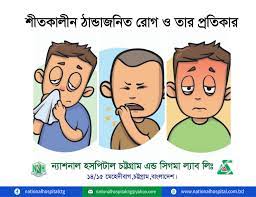Seasonal Flu in Bangladesh Seasonal flu, also known as influenza, is a common respiratory illness caused by influenza viruses. In Bangladesh, like in many other parts of the world, seasonal flu presents significant public health challenges due to its widespread prevalence and impact on individuals and communities. Understanding the nature of seasonal flu in Bangladesh involves examining its epidemiology, symptoms, prevention measures, healthcare responses, and societal implications.
Epidemiology Seasonal Flu in Bangladesh

Seasonal flu in Bangladesh follows global patterns, with peak seasons typically occurring during the colder months, from November to February. The country experiences two flu seasons annually, primarily driven by influenza A and B viruses. These viruses constantly evolve, leading to new strains that can cause outbreaks and pandemics. The circulation of influenza viruses is influenced by various factors such as climate, population density, migration, and healthcare infrastructure.
Symptoms Seasonal Flu in Bangladesh
The symptoms of seasonal flu in Bangladesh are consistent with global flu patterns and include fever, cough, sore throat, body aches, fatigue, and respiratory symptoms. These symptoms can range from mild to severe and may lead to complications such as pneumonia, especially in vulnerable populations like the elderly, young children, pregnant women, and individuals with underlying health conditions.
Prevention Measures Seasonal Flu in Bangladesh
Public health authorities in Bangladesh emphasize preventive measures to reduce the spread of seasonal flu. These measures include:
- Vaccination: Encouraging annual flu vaccination for high-risk groups and healthcare workers to enhance immunity against prevalent flu strains.
- Hygiene Practices: Promoting frequent handwashing with soap and water, using hand sanitizers, and practicing respiratory etiquette (covering coughs and sneezes) to reduce virus transmission.
- Mask-Wearing: Encouraging the use of face masks, especially during flu outbreaks or in crowded settings, to prevent respiratory droplet transmission.
- Social Distancing: Advising individuals to maintain physical distance from others, particularly during flu seasons or in areas with confirmed flu cases.
- Public Awareness Campaigns: Conducting educational campaigns through mass media, healthcare facilities, and community outreach to raise awareness about flu prevention and symptoms.
Healthcare Responses
Bangladesh’s healthcare system responds to seasonal flu through various strategies:
- Surveillance: Monitoring flu activity through national and regional surveillance systems to track flu trends, identify emerging strains, and guide public health interventions.
- Clinical Management: Providing healthcare facilities with guidelines for diagnosing and treating flu cases, especially severe or complicated infections requiring hospitalization or antiviral medications.
- Capacity Building: Training healthcare professionals on flu diagnosis, treatment protocols, infection control measures, and vaccination administration to ensure effective healthcare delivery.
- Collaboration: Collaborating with international health organizations, research institutions, and vaccine manufacturers to access updated flu vaccines, antiviral drugs, and technical expertise for flu prevention and control.
Societal Implications
Seasonal flu outbreaks in Bangladesh can have significant societal implications:Seasonal Flu in Bangladesh
- Economic Impact: Flu-related absenteeism from work or school, healthcare expenditures, and reduced productivity can strain households, businesses, and the overall economy.
- Healthcare Burden: Flu outbreaks can overwhelm healthcare facilities, leading to increased demand for medical services, hospital beds, and healthcare supplies during peak flu seasons.
- Vulnerable Populations: Vulnerable groups such as low-income communities, migrant workers, and densely populated urban areas may face heightened risks due to limited access to healthcare, crowded living conditions, and economic challenges during flu outbreaks.
- Education and Awareness: Promoting flu awareness, vaccination campaigns, and health education in schools, workplaces, and communities can empower individuals to take preventive actions and seek timely healthcare,Seasonal Flu in Bangladesh reducing flu-related complications and transmission.
- In conclusion, seasonal flu in Bangladesh mirrors global flu patterns, with distinct peak seasons, prevalent virus strains, and public health challenges. Effective flu prevention and control strategies encompass vaccination, hygien



Leave a Reply